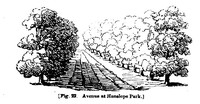HANSLOPE. Most of the large trees at Hanslope stand in avenues, yet their pleasant shade forbids the cutting down many of them, merely because the false taste of former times has planted them in rows; at least till those plantations which are now made shall better replace the shelter, which the avenues in some measure afford. The following sketch [our figs. 22 and 23] gives an idea of breaking the avenue to the north, which is not to be done by merely taking away certain trees, but also by planting a thicket before the trunks of those at a distance; as we may be thus induced to forget that they stand in rows. The addition of a few single trees, guarded by cradles, though often used as an expedient to break a row, never produces the desired effect: the original lines are for ever visible*.
*[It is of little consequence from what spot the drawing, No. IX. [our figs. 22 and 23] was taken, since all avenues bear so great a resemblance to each other. I shall here enumerate a few instances in which avenues have been submitted to my consideration. At Cobham Park I give reasons for preserving one, and destroying the rest; at Prestwood, for retaining the avenue; at Tatton Park, for quitting the avenue, and planting it up; at Trewarthenick, an avenue was very easily broken, from its having been planted on uneven ground; and at Brookmans, I elucidate the necessity of fixing on proper trees to form the outline in breaking an avenue; or, if the trees have stood so long near each other that no good outline can be formed, then the tops of some neighbouring trees may be so introduced as in some degree to supply the defect. An avenue of firs is the most obstinate to break, because they leave no lateral branches; and, therefore, in the stupendous double row of large silver firs, which the false taste of the last century has planted at Herriard's house, I have advised the destruction of one half, leaving the other as a magnificent specimen of the ancient style in gardening.]



